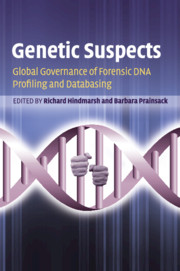Book contents
- Frontmatter
- Contents
- List of contributors
- About the contributors
- Foreword
- Acknowledgements
- 1 Introducing Genetic Suspects
- Section 1 Key areas in DNA profiling and databasing
- Section 2 National contexts of forensic DNA technologies and key issues
- 7 DNA databases and the forensic imaginary
- 8 Partners in crime: the use of forensic DNA technologies in Austria
- 9 Inquisitorial forensic DNA profiling in the Netherlands and the expansion of the forensic genetic body
- 10 DNA the Nor-way: black-boxing the evidence and monopolising the key
- 11 Portuguese forensic DNA database: political enthusiasm, public trust and probable issues in future practice
- 12 On trial! Governing forensic DNA technologies in the USA
- 13 Biosurveillance and biocivic concerns, from ‘truth’ to ‘trust’: the Australian forensic DNA terrain
- 14 Finding the balance: forensic DNA profiling in New Zealand
- 15 Forensic DNA profiling and databasing: the Philippine experience
- Section 3 Conclusions
- Index
- References
12 - On trial! Governing forensic DNA technologies in the USA
from Section 2 - National contexts of forensic DNA technologies and key issues
Published online by Cambridge University Press: 05 October 2012
- Frontmatter
- Contents
- List of contributors
- About the contributors
- Foreword
- Acknowledgements
- 1 Introducing Genetic Suspects
- Section 1 Key areas in DNA profiling and databasing
- Section 2 National contexts of forensic DNA technologies and key issues
- 7 DNA databases and the forensic imaginary
- 8 Partners in crime: the use of forensic DNA technologies in Austria
- 9 Inquisitorial forensic DNA profiling in the Netherlands and the expansion of the forensic genetic body
- 10 DNA the Nor-way: black-boxing the evidence and monopolising the key
- 11 Portuguese forensic DNA database: political enthusiasm, public trust and probable issues in future practice
- 12 On trial! Governing forensic DNA technologies in the USA
- 13 Biosurveillance and biocivic concerns, from ‘truth’ to ‘trust’: the Australian forensic DNA terrain
- 14 Finding the balance: forensic DNA profiling in New Zealand
- 15 Forensic DNA profiling and databasing: the Philippine experience
- Section 3 Conclusions
- Index
- References
Summary
INTRODUCTION
When DNA profiling was first introduced into the American legal system in late 1987, judges and prosecutors heralded it as the ‘greatest advance in crime fighting technology since fingerprints’ (People of New York v. George Wesley and Cameron Bailey 1988). Press accounts proclaimed that the technique would ‘revolutionize’ law enforcement (Lewis 1988; Marx 1988; Moss 1988). In many ways, it has. In the past two decades, DNA evidence has been used in the USA to solve countless violent crimes that might otherwise have been relegated to cold case files, putting thousands upon thousands of rapists and murderers behind bars and inducing guilty pleas from thousands more. Arrest warrants have been issued based solely on crime scene DNA profiles (Bieber 2002; Denver District Attorney 2008). Millions of profiles are now stored in a national DNA database, ready to be used in the aid of criminal investigations around the country. DNA evidence has even been used to free more than 250 ‘wrongfully convicted’ individuals from prison – until recently a uniquely American phenomenon that signals both the problems inherent in the country's criminal justice system and its faith in the power of science to bring the truth to light (Innocence Project 2010).
Yet, the introduction and development of DNA profiling in the USA has been far from perfect. Although closure, if not complete resolution, has been achieved in the majority of debates over molecular biology and population genetics that once affected the legal admissibility of the technique (Thompson 1993; Derksen 2003; Aronson 2007; Lynch et al. 2008), several issues remain inadequately addressed by the scientific and legal communities.
- Type
- Chapter
- Information
- Genetic SuspectsGlobal Governance of Forensic DNA Profiling and Databasing, pp. 240 - 261Publisher: Cambridge University PressPrint publication year: 2010
References
- 1
- Cited by



